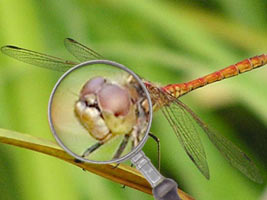Vision
The eyes of insects are truly wonderful!
A fly sitting of a flower easily looks around: it may look up, down, back. It does this without turning the head: its eyes are large and round — about half the head size!

The eyes of a dragonfly are even larger. They are two huge iridescent hemispheres looking in all directions simultaneously. A dragonfly flies and, like a fighter pilot, watches everything in the air. If a horse fly or mosquito flies by, the dragonfly turns and catches it in the air.
Eyes of flies, dragonflies, and most of other in-sects are called compound and have a complex structure: they consist of many convex hexagonal facets.
Each facet represents the surface of a separate small eye called ommatidium. And the number of ommatidia may be staggering! In the compound eyes of dragonflies there may be as many as 28 000 ommatidia, in the eyes of butterflies — 17 000, housefly — 4000! Such eyes ensure a very wide field of vision.
Moreover: many well-flying insects in addition to compound eyes have also 2 or 3 simple eyes situated on the head between the compound eyes.
The eyes of aquatic whirligig beetles (Gyrinidae) are quite unusual. Each eye is divided horizontally by a partition in two parts: the lower part ensures vision in water, the upper part — in air. Thanks to this, whirligig beetles can watch the situation in two environments simultaneously.
There are insects with very small eyes or with no eyes at all, for example worker termites living under-ground. Completely blind insects are found also in caves.
* * *
Scientists found out that bees remember their hive not just by outer appearance, but also by view of the surroundings. If one moves the hive on the ground 2 meters away, the bees coming back to it be-come confused, flying to the place where the hive was formerly. But if the hive is placed of a raft on a lake and the raft is moved to some distance (even to a kilometer), the bees easily find their hive, because the hive on the raft is the only mark of the lake surface.
-2.jpg)